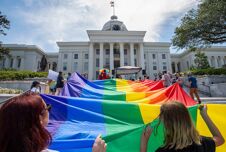Women and femmes have long been the LGBTQ+ community’s invisible force, often holding hands on the front lines but never quite making the cut of importance and relevance. This shrinking notoriety diminishes even further when considering race, specifically the intersection between queerness, Blackness, and gender.
My community has made moves to place ourselves in the regularity of life, no longer attempting to assimilate into the corners or shadows where society says we belong. As someone with many strikes on her head (Black, queer, and woman), I’ve seen the passing revolutions of every single identity in real time. Even in the wakes of hardships and death, there has always been a pillar of hope and space, mainly found in the ever-melting pot that is New York City. A safe haven, right?
Related:
Are queer women the future of tech?
With the advancement of Chat GPT and other AI technologies, Lesbians Who Tech founder Leanne Pittsford says workforce diversity is critical.
Somewhere amid the festering hatred and spoils of middle America, we are afforded the luxury of seeing so many familiar faces – our own. Societal and grandiose New York fables detail how there will always be a safe space where your identity can run wild among those who truly see, love, and want to be with you. We flock to the city for significance. Escaping the corners of the country where legislation is determined to kill us, New York is supposed to be for us (or at least have a neighborhood for us), but I’ve concluded that no matter the niche or belief, my safe space might not ever really exist.
Never Miss a Beat
Subscribe to our newsletter to stay ahead of the latest LGBTQ+ political news and insights.
At this point, I’m sure you’re thinking I’m being dramatic. How could the place of twinkling lights not have even one area that allows me to flirt/dance/breathe freely without questions or qualms? Easy – the notorious and famous lesbian bars cater to our white counterparts and have a knack for making Black queer women uncomfortable to the point of no return. This is not to sully every queer woman bar in NYC. I understand the importance and relevance of staples like The Cubby Hole and Henrietta’s and the newest installment, Ginger’s Bar. The issue lies within the isolation. The lesbian community being notoriously small is a common stereotype, but truthfully, we aren’t afforded the same opportunity to create gatherings to reach and meet more people, thus, making the range of connection-building minute.
Historically, lesbian bars were born from “women-owned” (code for lesbian-friendly) restaurants/tearooms/speakeasies, and during their earliest curation amid the prohibition era, they stayed hidden from the public eye. There were the drags of alcohol consumption and that minor issue of homophobia that made it more comfortable beyond the dangerous gaze of others. That didn’t stop the American-born privilege of racism from the Village’s white queer locations, often displacing Black LGBTQ+ people. The Harlem Renaissance, therefore, included a prominent adoption of Black lesbian clubs like the Clam House, with notable performances by Ma Rainey and Gladys Bentley. We had to find somewhere to party. This separation continued throughout the century until the demolishing of the last Black lesbian bar.
Audre Lorde, a Black lesbian writer, recalls her time venturing to the downtown (primarily white working class) lesbian bars: “I walked down those three little steps into the Bagatelle on a weekend night in 1956. There was an inner door, guarded by a male bouncer, ostensibly to keep out the straight male intruders come to gawk at the “lezzies,” but in reality, to keep out those women deemed ‘undesirable.’ All too frequently, undesirable meant Black.”
With displacement making its rounds, it bears the question of where we go to let loose. Again, I don’t want to diminish the significance of having these spots in the first place, especially with the long history of raids and reestablishments – building and rebuilding – but there is a trend of finding satisfaction in making something exclusionary. And that’s what I’m faced with. I walk into one of the three remaining lesbian bars and am hit with stares or a performative dance of welcoming me in (probably from the obvious notion that I’m not accepted). Hearing some off-the-wall question while slurping my tequila and lime juice or fending off a creepy hand trying to rub my blonde fade, a b**ch just wants some peace (and a nice pair of hips grinding on me to UMI). How can you entirely blame them when this scene is curated for their experiences, tastes, and lovers? I’m the outlier.
Yes, there are parties dedicated to Black lesbians and queer people, like Raw Honey and Gush, but those come around once every few months with costly tickets to keep the party going. Is our best hope to sit by our phones, wishing for the release of the next party while the remaining months we sandwich in between women who aren’t looking for us? No. Don’t we deserve to walk into a neighborhood bar, grab a cheap drink, and eye-f**k someone across the room?
Speaking with other NYC Black queer women, we feel a commonality of being treated like a performer in more ways than one. The concept of being an exotic or dominant toy eager to please feels eerily similar. It is as if the spaces occupied resort to the same essence of regular bars where men lurk in corners hoping to “turn” someone. There isn’t an exchange of power between two mutual parties. Jordyn Malone, an NYC Black queer creative, expressed the discontent of being bombarded in bars claiming to represent lesbians. “There’s nothing worse than the Woods on a Wednesday. Just a bunch of white bottoms with straps in their tote bags.”
Patience Oshunbiyi speaks on her experience as a Black lesbian photographer attempting to capture the nightlife of her community. “[As an event photographer], the only way I can get my camera roll to have more Black portraits is if I go to the straight bars catered to Black people. I think what I could do to bring in more Black lesbian, enby, trans faces to my portfolio, and there aren’t any spaces”
The discontent stems further than romantic and sexual connections. There is also a genuine lack of community spaces. Oshunbiyi states, “Sometimes I just want to go out and meet other cool Black lesbians with the same identity as me. Someone I can relate to and build upon. We end up being in Black gay male spaces because it’s the only hope we might see someone like us, and the music won’t be whack.”
And don’t get me wrong, we love our brothers and honor the space they hold for us at their functions and parties – but we don’t have to be a conglomerate. Black lesbians, gays, trans folks, and all those in between aren’t a monolith we can squeeze together for subconscious (and conscious) desires to keep out the undesired.
So, where do we go from here? We acknowledge the lack of curation for us and how we urge to be seen from behind the curtain of the queer community. Our voices must be heard and revered. We can no longer wait on the sidelines with the optimism of someone else recognizing the strife. Black lesbian and queer women deserve carefree occupancy in the melting pot.















